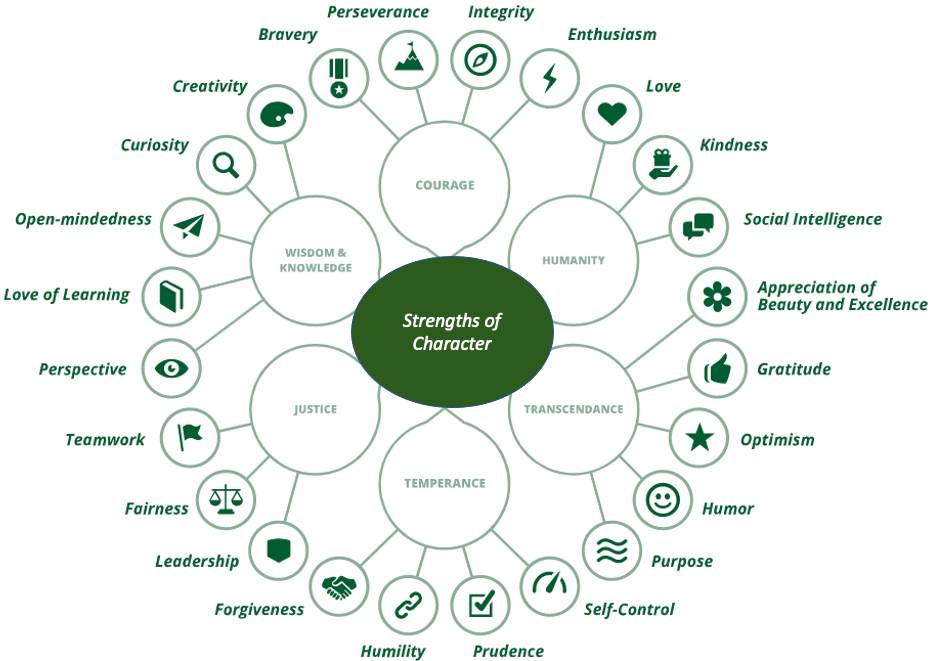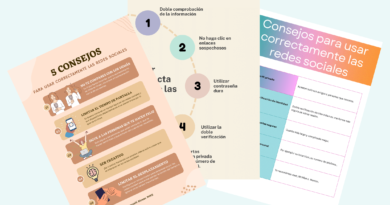Celebrating Strengths of Character
What are some of the qualities you like best about yourself? If you’re like many people, you may haven’t thought very much about that question. You might be more likely to focus on the things you don’t like about yourself, your weaknesses, your areas of improvement, and/ or the qualities you see in other people that you wish you had.

Indeed, it seems to be common for people to be more aware of their deficits rather than their strengths. Although this holds true both in and out of school, I find it to be particularly relevant in school settings. Teachers often tend to focus more on students’ weaknesses and areas that need improvement, rather than the things they are already good at. Of course it’s critical to help our students where they are struggling. However, what is equally important, and what is often overlooked in schools, is the focus on students’ pre-existing strengths. That is, the strengths that students already have — the strengths they bring with themselves into the classroom. Research has shown that focusing more on students’ intrinsic strengths (i.e., strengths of character) can help promote their positive identity and numerous other positive outcomes.
So what exactly are strengths of character?
These types of intrinsic strengths are now known in psychology as strengths of character and can be defined as “pre-existing positive qualities that arise naturally, feel authentic, and are intrinsically motivating to use” (Brdar & Kashdan, 2010). Strengths of character include strengths such as leadership, perseverance, love of learning, creativity, curiosity, forgiveness, fairness, gratitude, humour, and so forth. These are different from other types of strengths such as “being good at football” or “being good at math”. Strengths of character can be viewed as the positive aspects of our personality that are always with us, rather than the type of strengths that simply reflect ‘things we are good at doing’.

Years of research has uncovered 24 distinct character strengths and suggests that everyone– adults and children alike– has a unique strengths-profile with a different combination of signature strengths (i.e., your most natural strengths). When we use our signature strengths it is a fulfilling, happy experience that promotes a positive self-identity aligned with our intrinsic interests and personal values (Niemiec, 2017). To put it simply, if one of your signature strengths is leadership, then you will be happier when you are in a leadership role, for example.
In school settings, research has shown that identifying and developing students’ character strengths can lead to significant increases in student engagement, intrinsic motivation, life satisfaction, hope, class cohesion, and academic performance (Madden et al., 2011; Quinlan et al., 2015; 2018; Rashid et al., 2013). The goal then, for me as a teacher, is to incorporate these strengths of character into my teaching as much as possible. This can be done in many ways such as consciously noticing students’ strengths more frequently and telling them about it to positively reinforce the strength; by providing students with more space and opportunity at school to use their signature strengths in new ways; and/ or by examining the character strengths of book characters and historical figures and then comparing them to ourselves and people we know.
If you are are curious to learn more about your strengths of character, there is a free scientifically-validated survey that you can take. It has been used in hundreds of scientific research papers and it has been taken by over 13 million people in nearly every country around the world. It’s free and has been translated to dozens of different languages, including Slovak.
You can learn more about your signature strengths of character here: https://www.viacharacter.org/
Note: For the survey, there is an adult version and a youth version for children aged 10+

Sources:
Brdar, I., & Kashdan, T. B. (2010). Character strengths and well-being in Croatia: An empirical investigation of structure and correlates. Journal of research in personality, 44(1), 151-154.
Madden, W., Green, S., & Grant, A. M. (2011). A pilot study evaluating strengths-based coaching for primary school students: Enhancing engagement and hope. International Coaching Psychology Review, 6(1), 71-83.
Niemiec, R. M. (2017). Character strengths interventions: A field guide for practitioners. Hogrefe Publishing.
Quinlan, D. M., Swain, N., Cameron, C., & Vella-Brodrick, D. A. (2015). How ‘other people matter’ in a classroom-based strengths intervention: Exploring interpersonal strategies and classroom outcomes. The Journal of Positive Psychology, 10(1), 77-89.
Quinlan, D., Vella-Brodrick, D. A., Gray, A., & Swain, N. (2018). Teachers matter: Student outcomes following a strengths intervention are mediated by teacher strengths spotting. Journal of Happiness Studies, 1-17. doi: 10.1007/s10902-018-0051-7
Rashid, T., Anjum, A., Lennox, C., Quinlan, D., Niemiec, R. M., Mayerson, D., & Kazemi, F. (2013). Assessment of character strengths in children and adolescents. In Research, applications, and interventions for children and adolescents (pp. 81-115). Springer, Dordrecht.




